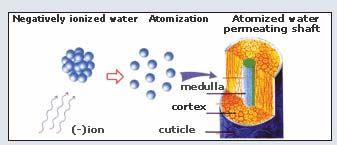
Walk into any salon, beauty supply or neighborhood store and you’re bombarded with products emblazoned with the “ion” label, including ionic blow dryers, flat irons, curling irons, conditioning treatments and even brushes!
Many products these days are labeled ionic, such as Bio Ionic’s IonTherapy and a number of Chi products.
Devachan’s new DevaSun Dryer uses ionic technology.
Many claim to transform your dry, frizzy flyaways into smoother, shinier locks. And since we’re always looking for new ways to battle frizz, many curlies buy into the ion craze. But is it just hype or do these ionic products really make a difference?
“The answer is, it depends on the product and the quality of the product,” says Ivan Hoot, director of education and training for Andis Co., which produces ionic dryers, flat irons and curling irons. “The biggest issue here is that there’s an awful lot out there for consumers to digest.”
And it all sounds so confusingly scientific. It helps to understand what an ion is — and why on earth manufacturers are urging us to put them in our hair!

Bio Ionic’s IonTherapy
Positive- and negative-charged ions are molecules that have added or lost an electrical charge, depending on the environment they’re in. We can’t see them, but ions exist in the air we breathe.
You know that amazing feeling you get when you’re breathing fresh air in the mountains or on the beach? The air in these pristine environments is packed with negative ions that are calming and soothing. At the same time, urban living has polluted air that’s full of positive ions — and those aren’t so good for you, or your curly locks.
“The ions in our hair, skin and nails are positively charged,” says Woody Michleb, Artistic Director for Farouk Systems. “If you’re drying your hair with a regular blowdryer it pushes out positive charges, which cause the cuticle covering the hair shaft to open, and this translates to frizzy, dry, hair. Ionic tools, such as irons and blowdryers emit negative charges, which calm down the outer layer of the hair and make the hair appear shinier and more manageable.”
Not everyone is buying into the ion craze. Stylist Ethan Shaw of Anne Kelso Salon in Austin, Texas, says he tested ionic dryers when they first came out several years ago. He was not impressed.

Chi Color Protection System
“We soaked a mannequin head in water, towel dried it, and then dried it as fast as we could with an ionic dryer,” Shaw says. “We then repeated the experiment with a conventional dryer. In our test, the hair looked exactly the same after we dried it with each dryer, and the ionic one actually took a minute longer to dry the hair. It was hard to believe the ionic label was anything other than excellent marketing. I’ve found the same thing with everything else I’ve seen that has the ionic label. I would love to see an ionic shampoo or conditioner that actually does something that others can’t, but I haven’t seen it yet.”
Ironically, Shaw uses an ionic dryer now, but only because it’s hard to find one that isn’t ionic. He says he still can’t see any difference in results, whether the ion switch is on or off.
Meanwhile, Hoot warns that not all ionic dryers are the same, despite their similar claims. For example, he says an ionic generator in the barrel of a blow dryer — the technology Andes uses — is going to produce a greater amount of these charged ions than an ion-charged component in the air stream, such as a front grill or a ring in the barrel.
“Ionic technology, when and where it is good-performing technology, truly provides a benefit. I think ionic is here for quite some time,” Hoot explains.
